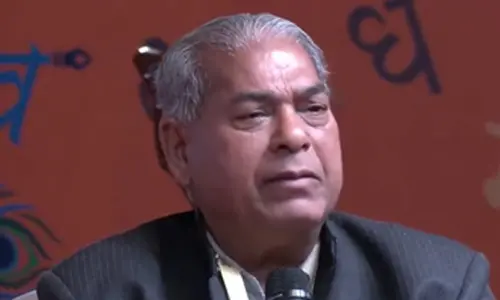GLOBAL TIGER DAY: Losing tiger habitats is a serious warning

India doubles tiger numbers 4 years ahead of schedule
Our Environment Minister Bhupender Yadav in the concluding session of G20 ministerial meeting on climate change in Naples, Italy on July 23 pointed out that world has waited long enough for delivery of the promised climate finance and technologies at low cost, but rich nations have failed to act.
Our Environment Minister Bhupender Yadav in the concluding session of G20 ministerial meeting on climate change in Naples, Italy on July 23 pointed out that world has waited long enough for delivery of the promised climate finance and technologies at low cost, but rich nations have failed to act.
It is easy for US, UK and EU to pledge 'net zero emission' by mid century, but how we plan and implement our transition from coal, oil and natural gas based economy to renewable energy based in the current decade is more important.
During last one month we have seen unprecedented heat waves in western Canada and north western USA, wild fire in Lytton reducing the city to ashes, forest fire destroying 1.5 million ha of Siberian forest (coldest Taiga region), thousand years record breaking rainfalls in western part of Germany, more than 700 mm of rainfall in three days in Henan province, China, more than 500 mm of rainfall in a day in Ratnagiri, Raigarh and Mahabaleshwar areas of Maharashtra causing extensive damage to life and property and bringing misery to people everywhere.
India's action for commissioning 450 Giga watt power clean energy by 2030 is quite on course, but a lot more has to be done in afforesting 26 million ha degraded forest land which can be sink for 2.5 to 3 Giga ton of CO2. At the same time country must ensure that existing natural forest is not allowed to degrade.
Forest Survey of India report indicates the addition of green cover outside notified forests and loss in the notified forests. Even tiger habitats have shrunk.
In the fourth cycle of All India tiger estimation during 2018-19, totally 3,81,400 sq km forested habitats in 20 states were surveyed and for the first time in this cycle abundance of co-predators, prey animals and status of tiger habitats along with tiger estimation were worked out. Camera traps were deployed in as many as 26838 locations, a number that entered Guineas' Book of records.
The estimation revealed that India has 2967 tigers in wild, nearly 70 per cent of total population of tigers in all 13 tiger range countries. Camera traps had covered 1,21,337 sq km tiger habitats, which is less than one third of the total area surveyed in the exercise. Many of wild animals were captured in Cameras including 2461 individual tigers.
Presently there are 52 tiger reserves in India and core and buffer of these reserves constitute 2.6 per cent of total geographical area. Reforms were undertaken after tigers vanished from Sariska and National Tiger Conservation Authority (NTCA) was constituted. Wildlife (Protection) Act, 1972 was amended to introduce a special chapter on NTCA in 2006.
Guidelines for managing tiger areas were evolved over period of time with series of interactions with stakeholders, staffs, study of transforming landscapes, tiger agenda, and multiple land use agenda etc. Legal and administrative reforms were undertaken and enabling provisions were added in the chapter.
For long term survival of tigers in any landscape we need 800 to 1200 sq km inviolate forested habitat with adequate prey population. Tigers travel long distances and the carrying capacity of the landscape would be 70 to 75 with male to female ratio as 1:2.
Forests have been severely impacted due to resource dependency of communities, and receded away from habitation with passage of time. Human induced changes have altered the dynamics of the landscape. Tiger occupancy was reported from 92,000 sq km area in the first cycle of estimation in 2006, and has been reduced to 88,000 sq km in the fourth cycle in 2018. Despite all stringent measures we have lost tiger occupied areas.
Western Ghats landscape itself has lost 527 sq km tiger occupancy in four years between 2014 and 2018. North eastern part of the country has lost more than 6000 sq km in this period. Loss of tiger habitat is an indication of degradation of forests and loss of Carbon sequestration potential.
Tiger being flagship specie, its protection ensures the conservation of other biodiversity i.e. number of species of flora and fauna. The tiger dynamics in relation with its source and sink areas has to be considered for sustainable population so that ecosystem services are intact. In tiger source areas there would be more births than deaths, while sinks will have more deaths than births. We should consider interventions in rural landscape, urban landscape and locking of Carbon for ensuring long list of ecological services to the society.
All departments of State and Central Governments should have master plan for landscape level development. We may need planning in smaller landscapes and then integrate them to work out master plan for bigger landscape. May be Government departments in the process would need consultations with stake holders, and villagers.
NTCA chapter introduced in 2006 in Wildlife (Protection) Act provides for "Steering Committee for Tiger Conservation" headed by Chief Minister. This is the opportunity for Departments to coordinate development proposals in larger landscape. Though landscape dynamics is changing fast, it must accommodate tiger dynamics as well.
Forest department on such forum can explain tiger dynamics, ecologically sensitive Zones, Management Plans of Protected Areas and requirement of 800 to 1200 sq km inviolate areas for tigers, needed for ecological services to the society. They must engage with stakeholders such as Infrastructure development, Revenue, Irrigation, Power, Horticulture, Railways, Roads & National Highways and plantation crops managers etc, who plan and implement landscape development.
Without clearance in this meeting, projects sacrificing wooded areas are taken to State Board for Wildlife in final shape, making tiger landscapes insecure. Loss of natural forests trigger global warming.
The challenge before the Forest Department is to consolidate the source areas of tigers. They need to standardize certain norms. Considering the plain and hilly terrains, unit has to be of manageable size, which can be perambulated by frontline staff of the Department.
We need to fix the norms for security related infrastructures, habitat related interventions, and ideal places for locating water holes. We must also keep an eye on prosecution and conviction rates as we must be sensitive to monitor and follow up the offence cases booked in the landscape. Our track record in offence monitoring has been very poor.
NTCA came up with a guideline on tourism in tiger reserves in October 2012, which has also been approved by Supreme Court. It says that the tourism in any tiger reserve can be restricted to 20 per cent of total core area or the area already in usage for tourism, whichever is less.
The tiger reserves being inviolate areas, managers must ensure that tourism is not allowed in remaining core areas. Thus we should clearly demarcate 'Go' and 'No Go' areas of the reserves and implement it in letter and spirit.
(The author is former Principal Chief Conservator of Forests (Head of Forest Force), Karnataka)
















